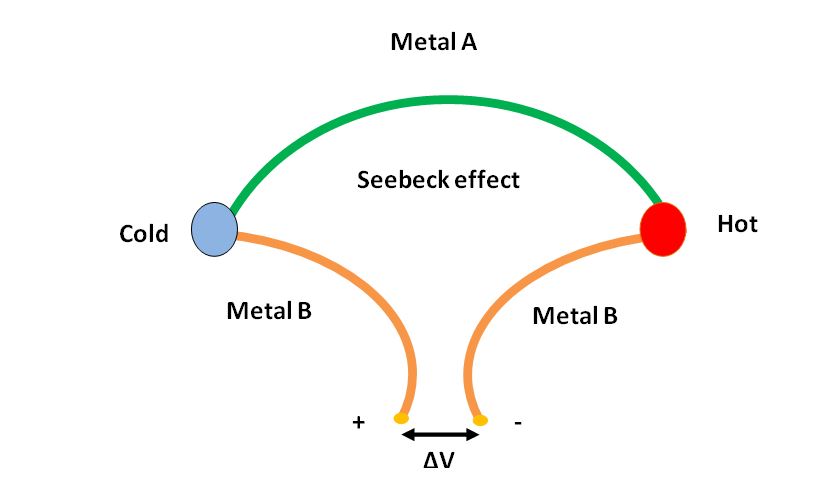Table of Contents
Introduction
The Seebeck effect, also known as the thermoelectric effect, is a phenomenon where a temperature difference between two different conductors results in the generation of an electric voltage. This effect was discovered in 1821 by Thomas Johann Seebeck, a German physicist. The Seebeck effect has numerous applications in thermoelectric generators, thermocouples, and temperature sensors. In this article, we will discuss the Seebeck effect, its applications, and its underlying principles.
The Seebeck effect is caused by the flow of heat from a hot region to a cooler region in a material. When a temperature difference exists across a material, the electrons in the material become more energetic on the hot side and less energetic on the cold side. This causes a flow of electrons from the hot side to the cold side, creating a voltage difference between the two sides.
Principles of the Seebeck Effect
The Seebeck effect is based on the principle of thermoelectricity, which is the relationship between temperature and electrical potential. When two different conductors with different temperatures are brought into contact, the electrons in the hot conductor gain energy and move to the cooler conductor. This creates a voltage difference between the two different conductors, and an electric current flows through the circuit.

The magnitude of the voltage generated by the Seebeck effect is proportional to the temperature difference between the two conductors and the properties of the conductors themselves. The relationship between the voltage and the temperature difference is described by the Seebeck coefficient, which is a material-specific constant. The Seebeck coefficient is defined as the ratio of the generated voltage to the temperature difference between the two conductors.
Applications of the Seebeck Effect
The Seebeck effect has numerous applications in thermoelectric generators, thermocouples, and temperature sensors.
Thermoelectric Generators:
Thermoelectric generators (TEGs) are devices that convert heat directly into electricity. TEGs are used in situations where a heat source is available, but it is not practical to use a conventional generator. For example, TEGs are used in spacecraft to convert the heat generated by the decay of radioactive isotopes into electricity.
Thermocouples:
Thermocouples are devices that measure temperature by exploiting the Seebeck effect. A thermocouple consists of two conductors of different materials that are connected at both ends. When one end of the thermocouple is heated or cooled, a voltage difference is generated that can be measured to determine the temperature difference between the two ends.
Temperature Sensors:
Temperature sensors are devices that measure temperature and convert the temperature into an electrical signal that can be read by a computer or other device. The Seebeck effect is used in temperature sensors to convert the temperature difference between two conductors into an electrical signal.
Challenges and Limitations of the Seebeck Effect
The Seebeck effect has some limitations that must be considered when designing thermoelectric devices. One limitation is the efficiency of the thermoelectric conversion process. The efficiency of a thermoelectric device is defined as the ratio of the electrical power generated by the device to the heat power supplied to the device. The efficiency of thermoelectric devices is typically low, around 5-10%.
Another limitation of the Seebeck effect is the materials used in thermoelectric devices. The Seebeck coefficient varies widely between different materials, and not all materials are suitable for use in thermoelectric devices. Materials with high Seebeck coefficients tend to have low electrical conductivity, while materials with high electrical conductivity tend to have low Seebeck coefficients.
Conclusion
The Seebeck effect is a fundamental principle in thermoelectricity that has numerous applications in thermoelectric generators, thermocouples, and temperature sensors. Despite its limitations, the Seebeck effect has the potential to revolutionize energy generation and temperature sensing technology. As research into new materials and device designs continues, the efficiency and applicability of the Seebeck effect will undoubtedly improve, leading to new and exciting applications in energy generation and temperature sensing.
Hope you liked this article “What is the Principles of the Seebeck Effect ?”. You are invited for any kind of suggestion or feedback in the comment box. You can also mail us your suggestions or feedback directly at theinstrumentguru@gmail.com. To read more such articles related to Technology, Electronics and Instrumentation. You can also download our Android App. Click here to download the mobile app.
Read Also
- Digital Integrated Circuit | What is an ICs?
- Pressure gauge thermometer | Liquid in metal Thermometer:
- Mercury Thermometer | Liquid in Glass Thermometer
- What is Logic Gate ?
- Control Wiring | Control Panel Wiring | Star Delta Power Wiring | Power wiring
- Wiring diagram | house wiring diagram | staircase wiring diagram
- Accuracy and precision
- What are the Errors in measurement ?
- Thermocouple